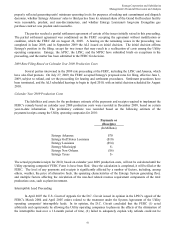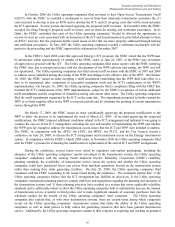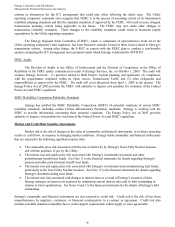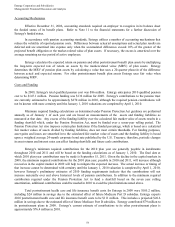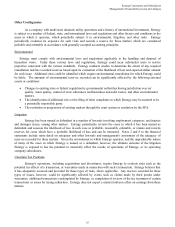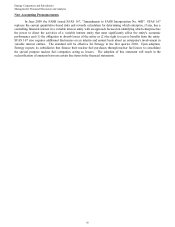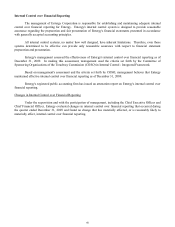Entergy 2009 Annual Report Download - page 53
Download and view the complete annual report
Please find page 53 of the 2009 Entergy annual report below. You can navigate through the pages in the report by either clicking on the pages listed below, or by using the keyword search tool below to find specific information within the annual report.
Entergy Corporation and Subsidiaries
Management's Financial Discussion and Analysis
49
Unbilled Revenue
As discussed in Note 1 to the financial statements, Entergy records an estimate of the revenues earned for
energy delivered since the latest customer billing. Each month the estimated unbilled revenue amounts are recorded
as revenue and a receivable, and the prior month's estimate is reversed. The difference between the estimate of the
unbilled receivable at the beginning of the period and the end of the period is the amount of unbilled revenue
recognized during the period. The estimate recorded is primarily based upon an estimate of customer usage during
the unbilled period and the billed price to customers in that month. Therefore, revenue recognized may be affected by
the estimated price and usage at the beginning and end of each period, in addition to changes in certain components of
the calculation.
Impairment of Long-lived Assets and Trust Fund Investments
Entergy has significant investments in long-lived assets in all of its segments, and Entergy evaluates these
assets against the market economics and under the accounting rules for impairment whenever there are indications
that impairments may exist. This evaluation involves a significant degree of estimation and uncertainty. In the
Utility business, portions of River Bend are not included in rate base, which could reduce the revenue that would
otherwise be recovered for the applicable portions of its generation. In the Non-Utility Nuclear business, Entergy's
investments in merchant generation assets are subject to impairment if adverse market conditions arise, if a unit
ceases operation, or for certain units if their operating licenses are not renewed. In the non-nuclear wholesale assets
business, Entergy's investments in merchant generation assets are subject to impairment if adverse market conditions
arise.
In order to determine if Entergy should recognize an impairment of a long-lived asset that is to be held and
used, accounting standards require that the sum of the expected undiscounted future cash flows from the asset be
compared to the asset's carrying value. The carrying value of the asset includes any capitalized asset retirement cost
associated with the recording of an additional decommissioning liability, therefore changes in assumptions that affect
the decommissioning liability can increase or decrease the carrying value of the asset subject to impairment. If the
expected undiscounted future cash flows exceed the carrying value, no impairment is recorded; if such cash flows are
less than the carrying value, Entergy is required to record an impairment charge to write the asset down to its fair
value. If an asset is held for sale, an impairment is required to be recognized if the fair value (less costs to sell) of the
asset is less than its carrying value.
These estimates are based on a number of key assumptions, including:
Future power and fuel prices - Electricity and gas prices have been very volatile in recent years, and this
volatility is expected to continue. This volatility necessarily increases the imprecision inherent in the long-
term forecasts of commodity prices that are a key determinant of estimated future cash flows.
Market value of generation assets - Valuing assets held for sale requires estimating the current market value
of generation assets. While market transactions provide evidence for this valuation, the market for such
assets is volatile and the value of individual assets is impacted by factors unique to those assets.
Future operating costs - Entergy assumes relatively minor annual increases in operating costs. Technological
or regulatory changes that have a significant impact on operations could cause a significant change in these
assumptions.
Timing - Entergy currently assumes, for a number of its nuclear units, that the plant's license will be
renewed. A change in that assumption could have a significant effect on the expected future cash flows and
result in a significant effect on operations.
Entergy's Non-Utility Nuclear business currently has pending applications for license renewals for the
Vermont Yankee, Pilgrim, Indian Point 2, and Indian Point 3 power plants. In addition, for Vermont Yankee the
state certificates of public good to operate the plant and store spent nuclear fuel also expire in 2012. Non-Utility
Nuclear filed an application with the Vermont Public Service Board on March 3, 2008 for approval of continued
operations and storage of spent nuclear fuel generated after March 21, 2012. Under Vermont law the Vermont
51


